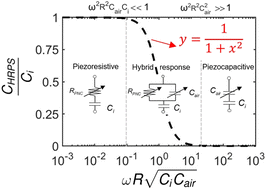Effects of AC frequency on the capacitance measurement of hybrid response pressure sensors†
Abstract
E-skins consisting of soft pressure sensors are enabling technology for soft robots, bio-integrated devices, and deformable touch panels. A well-known bottleneck of capacitive pressure sensors (CPS) is the drastic decay in sensitivity with increasing pressure. To overcome this challenge, we have invented a hybrid-response pressure sensor (HRPS) that exhibits both the piezoresistive and piezocapacitive effects intrinsic to a highly porous nanocomposite (PNC) with carbon nanotube (CNT) dopants. The HRPS is constructed with two conductive electrodes sandwiching a laminated PNC and a stiff dielectric layer. We have simplified the hybrid response into a parallel resistor–capacitor circuit, whose output depends on the AC (alternating current) frequency used for the capacitance measurement. Herein, through theoretical analysis, we discover a dimensionless parameter that governs the frequency responses of the HRPS. The master curve is validated through experiments on the HRPS with various doping ratios, subject to different compressive strains, under diverse AC frequencies. In addition, the relative contribution of piezoresistive and piezocapacitive mechanisms are also found to vary with the three parameters. Based on this experimentally validated theory, we establish a very practical guideline for selecting the optimal AC frequency for the capacitance measurement of HRPSs.

- This article is part of the themed collection: Soft Robotics


 Please wait while we load your content...
Please wait while we load your content...